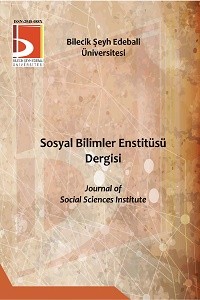Abstract
Yasemin
Devrimi, Tunus’un ötesinde etkiler ortaya koymuş, Arap Baharı diye adlandırılan
süreci tetiklemiştir. Süreci yoğun şekilde yaşayan Libya, Mısır ve Suriye gibi
ülkelerden farklı olarak Tunus, “Yasemin Devrimi” denilen bu baş kaldırıyı
toplumdaki dinamikleri önemli oranda uzlaştıran yeni bir anayasayla
sonuçlandırmıştır. Bu uzlaşı sürecinin kökeninde ne var? Diğer Arap Ülkelerinde
ortaya çıkan karşı devrim(Mısır), iç savaş(Suriye) ve kaos(Libya) ortamına
rağmen Tunus’ta istikrarın arkasında üç sacayağının olduğunu göreceğiz.
Demokrasinin vazgeçilmezlerinden çok partili hayat, sivil toplum kuruluşları ve
de Muhammed Gannuşi’nin siyasi dehası olduğu düşünülmektedir. Ayrıca İmmanuel
Wallerstein’in Dünya Sistemi teorisi ile Tunus’taki başarıyı açıklamadaki
yetersizliklere değinilecektir. Bu çerçevede şekillenen çalışmamız Tunus’ta
varılan sentezin, diğer ülkeler için bir model olma potansiyelini de gündeme
getirecektir.
References
- Arslantürk, Zeki ve Amman, Tayfun(2014) Sosyoloji Kavramlar, Kurumlar, Süreçler ve Teoriler, Çamlıca Yay. İstanbul
- Dursun, Hatice Rumeysa(2016) Otoriter Laiklikten Demoratik Laikliğe Türkiye ve Tunus’ta Din -Devlet İlişkilerinin Dönüşümü, Doktora Tezi, Tez No: 454583, İstanbul
- Feldman, Noah(2013) İslam Devleti, Çev: İhsan Durdu, Ufuk Yay. İst.
- Gannuşi, Muhammed el-Raşid(1987) İslami Yöneliş, Çev: Abdullah Baykal, Bir Yay. İst.
- Gannuşi, Muhammed el-Raşid(1996) İslam Toplumunda Vatandaşlık Hakları, Çev: Abdulmecit Can, Birleşik Yay. İst.
- Gannuşi, Muhammed el-Raşid(2016) Laiklik ve Sivil Toplum, Mana Yay. İst.
- Köktaş, Rümeysa(2016) Tunus Politik Kültüründe Sivil Toplum: Tarihsel Bir Analiz, Ormer Perspektif Ser, Sakarya
- Kenneth, Perkins (1986) Tunisia: crossroads of theIslamicandEuropeanworlds, Westview P. New York
- Kenneth, Perkins(2014) A History of Modern Tunisia,Cambridge University Press, New York
- Okumuş, Fatih(2015) İslami Hareketin İktidar Deneyimi: Tunus ve mısır, Mana Yay. İst.
- Özdalga, Elisabeth(2009) Tarihsel Sosyoloji, DoğuBatı Yay. Ankara
- Polat, Ferihan ve Durmuş, Ayşegül(2015) İmmanuel Wallerstein Perspektifinde Arap Baharı Tunus Örneği, Çizgi Kitapevi, Konya
- Shain, Emad Eldin(1998) Political Ascent: Political Movement in North Africa, Westview Pres, USA
- Tanrıverdi, Nebahat(2011) Yaklaşan Seçim Öncesi Tunus’ta Siyasal Denklemler. Ortadoğu Analiz C. 3, S. 34, ORSAM, Ankara
Abstract
The
Jasmine Revolution, has brought up influences beyond Tunisia, triggering the continuum
called the Arab Spring. Tunisia, unlike countries such as Libya, Egypt and Syria
where the process was intensive, the so called “Jasmine Revolution” ended up
with a new constitution that reconciles the dynamics of the society in a
significant way. What is in the origin of this reconciliation process? Despite
the counter-revolution (Egypt), civil war (Syria) and chaos (Libya) that have
emerged in other Arab countries, we will see that there are three trivets
behind the stability in Tunisia. Multiparty life from indispensable democracy,
non-governmental organizations and Muhammad Ghannouchi’s political genius are
thought to be more important. Furthermore, Immanuel Wallerstein’s World System
Theory and the inability to explain success in Tunisia will be addressed. Our
shaped work in this context, the synthesis reached in Tunisia will be the potential
model for other countries.
References
- Arslantürk, Zeki ve Amman, Tayfun(2014) Sosyoloji Kavramlar, Kurumlar, Süreçler ve Teoriler, Çamlıca Yay. İstanbul
- Dursun, Hatice Rumeysa(2016) Otoriter Laiklikten Demoratik Laikliğe Türkiye ve Tunus’ta Din -Devlet İlişkilerinin Dönüşümü, Doktora Tezi, Tez No: 454583, İstanbul
- Feldman, Noah(2013) İslam Devleti, Çev: İhsan Durdu, Ufuk Yay. İst.
- Gannuşi, Muhammed el-Raşid(1987) İslami Yöneliş, Çev: Abdullah Baykal, Bir Yay. İst.
- Gannuşi, Muhammed el-Raşid(1996) İslam Toplumunda Vatandaşlık Hakları, Çev: Abdulmecit Can, Birleşik Yay. İst.
- Gannuşi, Muhammed el-Raşid(2016) Laiklik ve Sivil Toplum, Mana Yay. İst.
- Köktaş, Rümeysa(2016) Tunus Politik Kültüründe Sivil Toplum: Tarihsel Bir Analiz, Ormer Perspektif Ser, Sakarya
- Kenneth, Perkins (1986) Tunisia: crossroads of theIslamicandEuropeanworlds, Westview P. New York
- Kenneth, Perkins(2014) A History of Modern Tunisia,Cambridge University Press, New York
- Okumuş, Fatih(2015) İslami Hareketin İktidar Deneyimi: Tunus ve mısır, Mana Yay. İst.
- Özdalga, Elisabeth(2009) Tarihsel Sosyoloji, DoğuBatı Yay. Ankara
- Polat, Ferihan ve Durmuş, Ayşegül(2015) İmmanuel Wallerstein Perspektifinde Arap Baharı Tunus Örneği, Çizgi Kitapevi, Konya
- Shain, Emad Eldin(1998) Political Ascent: Political Movement in North Africa, Westview Pres, USA
- Tanrıverdi, Nebahat(2011) Yaklaşan Seçim Öncesi Tunus’ta Siyasal Denklemler. Ortadoğu Analiz C. 3, S. 34, ORSAM, Ankara
Details
| Primary Language | Turkish |
|---|---|
| Journal Section | Articles |
| Authors | |
| Publication Date | June 1, 2018 |
| Submission Date | February 7, 2018 |
| Acceptance Date | February 27, 2018 |
| Published in Issue | Year 2018 Volume: 3 Issue: 1 |


